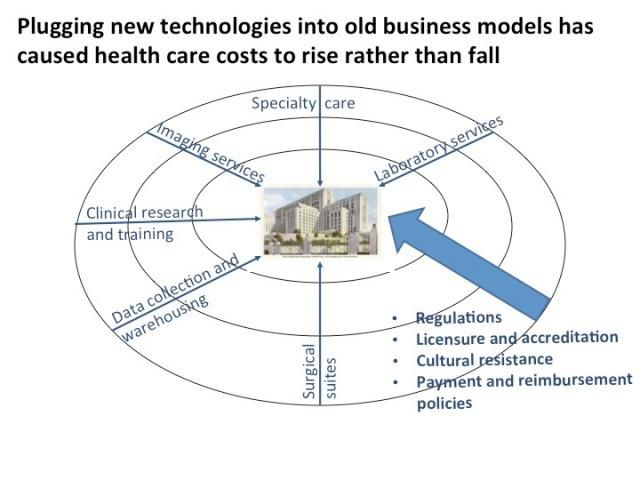Healthcare Innovation: Only in the US?

Almost any discussion related to improving healthcare, whether it implies reducing costs or improving patient outcomes and satisfaction, usually has technology as a core component.
Technology, in and of itself will not solve the problems, but used appropriately it will contribute to the transformation of healthcare, as it has in many other industries. Comparably to internet business, where the US is leading it looks like the same thing could happen in healthcare, too. Obviously, the US is under the most pressure to change their healthcare landscape but that shouldn’t push us Europeans into the spectator / copy role where we find ourselves in E-Commerce and Social-Mobile.
The reason for why technology alone cannot be the solution for all the problems present in healthcare is well-described by Clayton Christensen and Dr. Jason Hwang in their book “The Innovator’s Prescription”.
The gist is that applying technology within the traditional delivery and mental models will not reduce costs but actually increase them. This can be summarized with “do more / bill more” and is the way healthcare is reimbursed in Germany and most other countries.

Healthcare Innovation
Therefore, now that everybody is talking about a lack in innovation and vision from today’s entrepreneurs starting a disrupting model in healthcare is more attractive than ever.
And indeed, 2012 seems to be the best time to become an entrepreneur in the health sector. Not only is it one of the few sectors where to do well one must do good. It is also one of a few sectors where if you do good you can do really well.
In the US different innovative providers successfully emerged and showed that indeed the status quo is far from optimal. What these models, such as Qliance and MedLion have in common, is their focus on primary care and prevention. Thanks to their use of technology and by redesigning the delivery model (e.g. charging a flat fee for access and not by income or risk) Qliance demonstrated a reduction in healthcare costs of up to 80%.
Although, health systems in Europe are much more cost efficient than in the US, there seems to be significantly less innovation going on. One major reason might be the stiff regulation startups face in healthcare. Another reason is definitely the harder monetization access: Europeans are used to getting healthcare “for free”.
In Germany, for instance, I cannot think of any example of an innovative healthcare delivery model. What we have here are regionally constrained tests on topics such as disease management and telemedicine. However, these tests are all driven by either the insurers or universities. To me, this all seems like too little too slow.
European Barriers
Are we not ready for disrupting innovation in Europe? It certainly is not the case that we do not realize that we need change. There are many barriers to change in place in Europe, though.
Unlike the US people in Europe are far less open to experimentation with new health models. In some countries like to UK, services only get reimbursed after they can demonstrate cost-effectiveness. Although, I support that approach I believe agreements should be put in place that would support experimentation and startups.
Especially when it comes to data, which is a very sensitive topic in Europe governments should be much more open. Open sourcing data in a sensitive way will certainly have a positive effect on innovation and is the only thing that could potentially result in breakthrough changes.